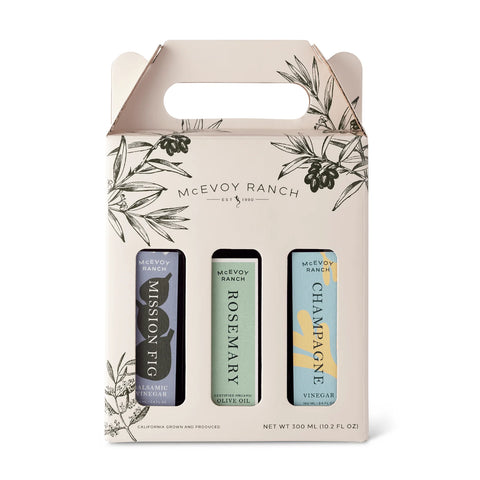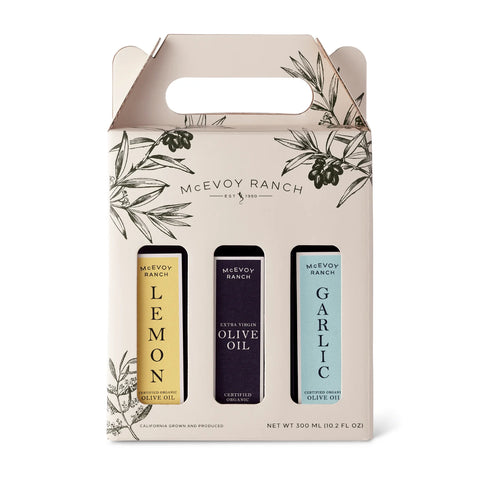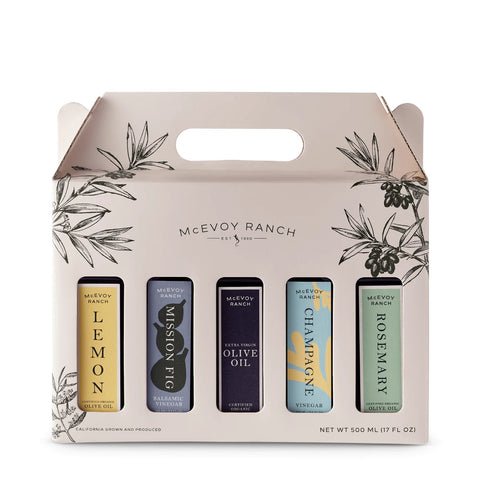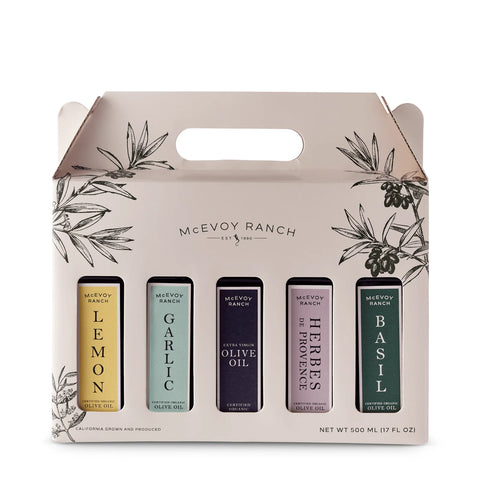
How is Olive Oil Made? The Ultimate Guide (2024)
Olive oil, a cornerstone of Mediterranean cuisine, has captivated food enthusiasts and health-conscious consumers worldwide.
At McEvoy Ranch, a family-owned 550-acre working farm in Petaluma, California, we've dedicated ourselves to producing some of the world's finest estate-produced extra virgin olive oil for over three decades.
In this comprehensive guide, we'll explore the fascinating journey of olive oil production, from grove to bottle, and share insights into what makes truly exceptional olive oil.
What Makes Extra Virgin Olive Oil Special?
Extra virgin olive oil (EVOO) is the highest grade of olive oil, revered for its superior flavor, health benefits, and minimal processing. This liquid gold has been a cornerstone of Mediterranean culture for millennia, with its importance stretching back to ancient civilizations.
Historical Significance and Modern Importance
Olive oil has been a symbol of wealth, health, and divine blessing since ancient times. The Greeks considered it a gift from the goddess Athena, while it played a crucial role in Roman trade and cuisine.
Today, EVOO continues to be a vital component of the Mediterranean diet, recognized by UNESCO as an Intangible Cultural Heritage of Humanity.
Strict Criteria for Excellence
To earn the coveted "extra virgin" designation, olive oil must meet exacting standards:
-
Production solely through mechanical means, without chemicals or excessive heat
-
Low free fatty acid levels (0.5% or less in California, which has stricter standards than the international trade standards for classifying extra virgin olive oil).
-
No sensory defects and positive fruitiness in flavor and aroma.
-
In addition, the oil must be made from 100% olives; no other ingredients are allowed in extra virgin olive oil (or in any grade of olive oil).
These stringent requirements, verified each harvest under the CDFA Olive Oil Commission of California (OOCC), ensure that EVOO retains the natural flavors, aromas, and health benefits of the olives, resulting in a high-quality, unadulterated oil.
EVOO is rich in monounsaturated fats, antioxidants, and anti-inflammatory compounds. Its quality olive oil can enhance the flavor of any dish. Health benefits include potential protection against heart disease, certain cancers, and cognitive decline, making it not just a culinary delight but also a nutritional superstar.
Market Overview and 2024 Trends
The global EVOO market continues to grow, driven by increasing health consciousness, concerns about sustainability and culinary appreciation.
Key trends include:
-
Sustainability focus: Consumers are increasingly seeking organic and sustainable food. Olive oil is the most sustainable cooking oil, using low water and nutrient inputs and storing carbon.
-
Premiumization: There's a growing demand for high-end, single-estate, and early-harvest EVOOs.
-
Health-driven consumption: Ongoing research into EVOO's health benefits is fueling market growth.
-
Culinary experimentation: Chefs and home cooks are exploring EVOO's use in non-traditional cuisines and even desserts.
Despite challenges such as climate change affecting production, the future of EVOO remains bright. Its combination of rich history, stringent quality standards, health benefits, and culinary versatility continues to secure its place as a prized ingredient in kitchens worldwide.
Types of Olive Oil
Olive oil comes in several types, each with distinct characteristics, production methods, and culinary uses. Understanding these types can help you choose the right oil for your cooking and flavor preferences. Here are the most common types of olive oil:
Extra Virgin Olive Oil (EVOO)
The highest grade of virgin (mechanically extracted) olive oil
Made from 100% mechanically processed olives, EVOO must meet strict standards for acidity (0.5% or less in CA) and have positive fruitiness and zero negative sensory qualities. EVOO is rich in antioxidants and healthy fats, making it a popular choice for dressings, drizzling over dishes, and dipping, compared to regular olive oil. It is also great for cooking. Its flavor profile can range from mild and fruity to robust and peppery, depending on the olive variety, ripeness of the fruit at harvest, and multiple other factors.
Virgin Olive Oil
The middle grade of virgin (mechanically extracted) olive oil
Virgin Olive Oil is also made from mechanically processed olives, similar to extra virgin olive oil, but it has a slightly higher acidity level, typically up to 2%. While the term "cold-pressed" is often associated with olive oil, modern production no longer uses pressing methods. Instead, centrifuges are employed to extract the oil efficiently and cleanly. Virgin olive oil retains much of the olive's natural flavor and health benefits, making it suitable for a variety of cooking applications. Virgin grade olive oil is rarely seen in the US market.
Olive Oil or Pure Olive Oil
A blend of refined olive oil and a small amount of virgin olive oil. The refining process removes all natural flavors and aromas, resulting in a mild taste. Some virgin olive oil is added back to make it palatable, making this oil versatile for frying and baking due to its higher smoke point.
Light or Extra Light (in Flavor) Olive Oil
Light olive oil undergoes the same refining process as pure olive oil but has less virgin olive oil blended back in. "Light" refers to the oil's flavor, not its calorie content. It has a very mild taste and a higher smoke point, suitable for high-heat cooking methods such as frying and sautéing.
Olive Pomace Oil
Derived from the leftover pulp, pits, and skins of olives after the initial extraction, this oil is extracted using solvents and then refined to produce a neutral oil. Olive pomace oil is in a separate category and is not classified as olive oil. It is less flavorful and lower in quality compared to olive oil and is used primarily in industrial cooking and food processing.
How is Olive Oil Made: From Grove to Bottle
The journey of olive oil is a meticulous process that requires expertise, precision, and care at every step. It begins in sun-drenched groves and ends with the carefully bottled product on your kitchen shelf.
Of course the production of olive oil begins with the cultivation and care of olive trees. The trees must be properly pruned and irrigated, and pests and diseases must be managed. Then it is time to make the olive oil!
This process can be broken down into several key stages:
-
Harvesting at the optimal time and prompt transportation to the mill.
-
Cleaning and washing of olives.
-
Crushing.
-
Malaxing.
-
Separation of oil from water and solids.
-
Storage and racking or filtration.
-
Bottling and packaging.
Each of these stages plays a crucial role in determining the final quality of the olive oil. Let's explore each step in more detail.
Harvesting Olives: The First Step in Olive Oil Production
Timing is crucial when it comes to harvesting olives for oil production. Producers carefully monitor their olive groves to determine the optimal moment for harvest. This typically occurs when the olives have reached their peak oil content but are still slightly underripe, ensuring a balance of flavor and polyphenol content.
The harvesting process itself can be done in several ways:
-
Traditional hand-picking: Olives are carefully picked by hand or with small hand-held rakes. This method is labor-intensive but gentle on the fruit and trees.
-
Assisted hand Semi-mechanical harvesting: A combination of mechanical aids and hand-picking, often used in medium-sized groves.
-
Mechanical harvesting: Machines shake the trees or brush the olives off the branches. This method is faster and more efficient for large-scale production.
Always prioritizing the care of their trees and the quality of their olives. Early harvesting often results in olive oil with higher polyphenol content, contributing to its health benefits.
Once harvested, the olives are quickly transported to the mill to preserve their freshness. Speed is crucial here, as olives begin to degrade as soon as they're picked. Many high-quality producers aim to process their olives within hours of harvesting.
Crushing: Transforming Olives into Paste
At the mill, the olives first undergo cleaning to remove leaves, twigs, and other debris. They're then washed to remove any dust or dirt. The first step in processing is crushing the olives, including the pits, into a paste. Traditionally, this was done with large millstones, but modern facilities often use hammer mills or blade mills.The goal is to break down the fruit's cell walls to release the oil. The type of crusher will affect the flavor profile of the finished olive oil.
Malaxation: Preparing the Paste
Crushing the olive fruit is followed by malaxation, a process where the olive paste is slowly mixed to help the tiny oil droplets combine into larger ones. During this process there is also biochemical activity as the different components of the olive are stirred together. This step typically takes 20-40 minutes and is carried out in stainless steel tanks.
The temperature during malaxation is carefully controlled, as heat can affect the oil's quality and classification. State-of-the-art milling equipment will allow control of both temperature and the atmosphere in malaxation. This approach allows for the extraction of the highest quality oil, maintaining the integrity of the olives' natural flavors and nutritional properties.
Extracting Olive Oil: Separating Oil from Water and Solids
After malaxation, the olive paste undergoes separation to separate the oil from the water and solid materials. There are two main methods for this:
-
Traditional pressing: The paste is spread on fiber mats, which are stacked and then pressed to squeeze out the oil and water. This method is much less common today but is still used by some producers.
-
Centrifugation: The standard process used in modern facilities, this method uses centrifugal force to separate the components based on their different densities. It takes place in two steps. First is the decanter, a horizontal centrifuge. There are two types of decanters:
-
Two-phase: Separates the paste into oil and wet pomace (i.e. two phases).
-
Three-phase: Separates the paste into oil, water, and dry pomace (i.e. three phases).
The careful extraction process is crucial in preserving the oil's quality and ensuring that it meets the strict standards for extra virgin classification.
Most modern olive milling facilities also have a second centrifuge, called the separator. The separator is also known as the vertical centrifuge or polisher. This last step separates any remaining water from the olive oil, as any excess water left in the olive oil can hasten the oil’s degradation through hydrolysis.
Storing and Bottling: Preserving Olive Oil Quality
Once extracted, the olive oil is typically stored in temperature-controlled stainless steel tanks to protect it from light and oxygen exposure. These tanks are often blanketed with nitrogen to prevent oxidation. Producers carefully monitor the oil during this period, removing any remaining sediment that occurs.
The oil may undergo a process called racking, where it's transferred between tanks to separate it from any sediment. This helps to clarify the oil and improve its stability. An alternative to racking is filtration. The olive oil is gently filtered to remove all remaining particles and moisture.
When it's time for bottling, great care is taken to minimize the oil's exposure to air, which can cause oxidation.
Many producers use dark glass bottles or tins to protect the oil from light. The bottling process is designed to preserve the oil's freshness and flavor, ensuring that quality is preserved after the oil leaves the production facility.
Olive Oil Varieties: Exploring Flavor Profiles
Different olive varieties produce oils with distinct flavor profiles. Although no exact numbers exist, it’s estimated that there are over 1,500 distinct cultivars of olives. The International Olive Council (IOC) estimates that 139 olive varieties grown in 23 countries account for roughly 85 percent of the world's olive production.
Understanding these varieties can enhance your appreciation of olive oil's diverse flavors and uses. Here are some popular olive varieties and some of their characteristics:
Popular Olive Varieties
-
Frantoio: Produces oil with a fruity flavor and peppery finish.
-
Leccino: Known for its delicate, mild flavor.
-
Pendolino: Often used in blends for its balanced flavor.
-
Arbequina: Produces a sweet and fruity oil with a slight nuttiness.
-
Picual: Known for its strong flavor with notes of tomato leaf and tropical fruits.
-
Koroneiki: Balanced oil with green banana and herbaceous flavors.
Many producers create blends of different varieties to achieve a well-balanced, complex olive oil with a unique flavor profile that represents the terroir of their region.
Regional Varieties
Olive oil production is deeply influenced by regional characteristics, including climate, soil, and traditional practices. Here are some notable regional varieties:
-
Italian Olive Oil: Italy produces a wide range of olive oils, with northern regions offering mild, slightly nutty oils, central regions producing stronger, grassy oils, and southern regions, including Sicily, known for both robust assertive oils and ones with softer more herbal flavors.
-
Spanish Olive Oil: Spain is the largest producer of olive oil, traditionally known for smooth, sweet, and fruity oils. Modern tastes have expanded the Spanish offering to include greener profiles. Popular varieties include Arbequina and Picual.
-
Greek Olive Oil: Greek oils are often herby, fruity, and sometimes peppery, making them versatile all-rounders. Koroneiki is a well-known Greek variety.
-
Californian Olive Oil: The United States, particularly California, has become a significant producer of high-quality olive oil. Californian oils are diverse, ranging from grassy and robust to mild and fruity, reflecting the state's diverse climate and production techniques.
Single-Origin vs. Multi-country Blends
-
Single-Origin Olive Oil: This type of olive oil is made from olives harvested from a single estate, region or country. Single-origin oils often have unique, intense flavors that reflect the specific terroir of the region. They are prized for their distinctive characteristics.
-
Multi-country Blend Olive Oil: Blends combine oils from different regions to create a consistent, balanced and complex flavor profile making these oils versatile for various culinary applications. Blending allows producers to achieve consistency in the face of cropping ups and downs and to assure accessibility in the market.
Single-Varietal (Monocultivar) vs. Varietal Blend Olive Oils
-
Single-Varietal Olive Oil: These are oils made from a single cultivar of olive. They are valued for their distinctive varietal character and uniqueness.
-
Varietal Blends (aka Coupages): Made with a blend of olive varieties, these oils can have extraordinary complexity and balance. Blending also allows for greater consistency in flavor profile from year to year.
Organic Olive Oil
Organic olive oil is produced without synthetic pesticides, herbicides, or fertilizers, adhering to organic farming practices that promote environmental sustainability. Organic certification ensures that the olives are grown and processed according to strict organic standards. Benefits of organic olive oil include:
-
Health: Organic farming practices create healthier working conditions for the farm workers and ensure there is no non-organic pesticide residue in your olive oil.
-
Environment: Organic farming supports biodiversity and soil health, reducing the environmental impact of olive cultivation.
-
Flavor: Many consumers believe that organic olive oil has a purer, more natural taste, free from chemical residues.
Grading and Certification: Ensuring Olive Oil Excellence
Olive oil quality and purity are subject to rigorous testing and verification processes. In California, for example, extra virgin olive oil is subject to the California Department of Agriculture (CDFA) olive oil standards and the Olive Oil Commission of California (OOCC) sampling and testing program.
Internationally, oils must meet standards set by organizations like the International Olive Council(IOC).
Purity (Authenticity) Testing
Olive oil purity (authenticity) standards assure that products labeled as Olive Oil contain no other oils. The purity standards also prohibit the presence of refined olive oil in virgin olive oil products. Purity testing looks at fatty acid composition, sterols, and other indicators.
Quality Testing
Olive oil quality testing involves both chemical analysis and sensory evaluation by trained experts. The chemical analysis checks for various parameters including:
-
Free fatty acid content (free acidity)
-
Peroxide value
-
UV absorbency
-
Moisture and Volatile matter
-
Insoluble impurities
-
Pyropheophytins (PPPs)
-
1,2 Diacylglycerols (DAGs)
Sensory Evaluation
The sensory evaluation, or organoleptic assessment, is conducted by a panel of trained tasters. They evaluate the oil for:
-
Positive attributes: fruitiness, bitterness, and pungency
-
Negative attributes: rancidity, fustiness, mustiness, etc.
An olive oil must have zero negative attributes (defects) and some olive fruitiness to be graded as extra virgin.
Quality Indicators
Several key factors relate to the quality of olive oil:
-
Low Free Fatty Acid Level: Extra virgin olive oil must have a free fatty acid (FFA) level less than 0.8%, 0.5% in California. Lower acidity generally indicates higher quality but FFA is only one of the tests that determine the grade of an olive oil.
-
Peroxide Value: This measures the oil's primary oxidation state. The standard for extra virgin grade is below 20 mEq O2/kg, 15 mEq under the CDFA standard.
-
Polyphenol Content: Polyphenols are an indicator of style, not quality. Higher levels of polyphenols indicate more antioxidants and a potentially more pungent flavor, but lower polyphenol (milder) oils are still healthy if that is what you prefer.
-
Harvest Date: Fresher oil is generally better. Look for bottles with a harvest date within the last 12-18 months to ensure you're buying quality olive oil. In the absence of a harvest date, choose a Best By Date as far in the future as possible.
-
Storage Conditions: Proper storage in dark bottles or tins, away from heat and light, helps maintain quality. Do not store your olive oil next to the stove.
-
Sensory Characteristics: High-quality extra virgin olive oil should have a fresh, fruity aroma and a balanced flavor profile. The level of bitterness and peppery notes will vary depending on the oil’s style.
Common Mislabeling and How to Spot Authentic Olive Oil
Authenticity and mislabeling in the olive oil industry are common concerns. Here are some tips to help you identify authentic, high-quality olive oil:
-
Look for Certification Seals: Seals from reputable organizations like the Olive Oil Commission of California (OOCC),North American Olive Oil Association (NAOOA), or the Extra Virgin Alliance (EVA) indicate that the oil has been tested and meets quality standards.
-
Check the Label: More detailed label information can be a sign of a committed, higher quality producer. Look for specific details such as the harvest date, region of origin, and the olive varieties used. Terms like "packed in" or "bottled in" do not tell you where the olives were grown. Look on the back label for the actual origin of the olives.
-
Price Point: While not always indicative of quality, extremely low-priced "extra virgin" olive oils should be viewed with skepticism. Producing high-quality EVOO is costly, and this is often reflected in the price.
-
Dark Glass or Tin Containers: Quality producers package their oils in materials that protect against light, which can degrade the oil. Bag-in-box is also excellent for preserving olive oil quality.
-
Taste Test: Although not foolproof for non-experts, genuine extra virgin olive oil should have a fresh, fruity aroma and can have a slightly bitter, peppery taste. If it tastes totally bland or rancid, it is likely not extra virgin.
-
"Best By" Date: While not as informative as a harvest date, a "best by" date can give you an idea of the oil's freshness. Look for a date that's about two years from when you're buying the oil.
-
Single-Source Oils: Oils produced from olives grown on a single estate or in a specific region can be higher quality and an indicator of an olive oil coming directly from the company that produced it.
By understanding these quality indicators consumers can make more informed choices when purchasing olive oil.
Health Benefits of Extra Virgin Olive Oil
Extra virgin olive oil is renowned for its health benefits, largely due to its high content of monounsaturated fats and powerful antioxidants. Regular consumption of high-quality EVOO has been associated with numerous health benefits, including:
-
Reduced risk of cardiovascular disease: The monounsaturated fats in olive oil can help lower bad cholesterol levels and reduce the risk of heart disease.
-
Anti-inflammatory properties: Compounds in olive oil, particularly oleocanthal, have been shown to have anti-inflammatory effects similar to ibuprofen.
-
Potential cancer-fighting properties: Some studies suggest that the antioxidants in olive oil may help prevent certain types of cancer.
-
Improved cognitive function: The Mediterranean diet, rich in olive oil, has been associated with better brain health and a reduced risk of neurodegenerative diseases.
Early harvesting practices often ensure that olive oil is rich in polyphenols, maximizing these potential health benefits.
Sustainable Olive Oil Production
Many olive oil producers are committed to sustainable farming practices. This can include organic certification, which reflects a commitment to environmentally friendly farming.
Sustainable practices often include:
-
Active soil-building programs to maintain soil health and fertility.
-
Irrigation sourced from rainwater and natural runoff to conserve water resources.
-
Production of organic compost from olive oil by-products, reducing waste.
-
Preservation of natural habitats for local flora and fauna to maintain biodiversity.
-
Use of integrated pest management to minimize chemical interventions.
-
Energy-efficient milling and production processes.
These practices not only benefit the environment but often result in healthier trees and higher quality olives, contributing to superior olive oil.
Cooking with Olive Oil: Tips and Techniques
Contrary to popular belief, extra virgin olive oil is excellent for cooking. Its smoke point (the temperature at which it begins to break down and smoke) is high enough for most cooking methods, including sautéing and frying.
Here are some tips for using olive oil in your kitchen:
-
Use it as a finishing oil to add flavor to soups, salads, and cooked dishes
-
Replace butter with olive oil in baking for a healthier twist
-
Drizzle it over vegetables before roasting for added flavor and nutrition
-
Use it as a base for marinades and dressings
-
Pair different olive oils with different dishes: use milder oils for delicate flavors and robust oils for stronger flavors
-
Store your olive oil in a cool, dark place to preserve its quality
Remember, fresher is better when it comes to olive oil. Unlike wine, olive oil does not improve with age, so aim to use it within a year or two of its harvest date for the best flavor and nutritional benefits.
Olive Oil Market Trends (2024)
Key Market Players
The olive oil market is dominated by several key players, including Spain, Italy, and Greece, which together account for a significant portion of global production. Spain remains the largest producer, contributing nearly half of the world's olive oil.
Other notable producers include Turkey, Tunisia, and Portugal. In recent years, countries like the United States, particularly California, and Australia have also emerged as influential players in the market, known for their high-quality. There are also many high-quality producers in Argentina and Peru.
Emerging Markets
Emerging markets in Asia, particularly China and India, are showing increasing interest in olive oil, driven by growing health awareness.
These markets present significant growth opportunities for producers, as consumers in these regions are beginning to appreciate the health benefits and culinary versatility of olive oil.
Sustainability and Ethical Production Practices
Olives are an inherently sustainable crop, being perennial and low water use. Olive orchards also store carbon efficiently and can be biodiverse environments. Sustainability and ethical production practices are becoming increasingly important in the olive oil industry. Consumers are more conscious of the environmental impact of their purchases and are seeking products that are produced sustainably.
This includes organic farming practices, water conservation, and fair labor practices. Producers are responding by obtaining certifications such as organic, low carbon and sustainably produced and by implementing environmentally friendly practices throughout the production process.
Price Trends and Economic Impact
The price of olive oil is influenced by various factors, including harvest yields, production costs, and global demand. In recent years, prices have been affected by climatic conditions such as droughts and heatwaves, which have impacted olive yields.
Economic factors, such as inflation and currency fluctuations, also play a role. Despite these challenges, the demand for high-quality extra virgin olive oil continues to grow, supporting a robust market.
Buying and Storing Olive Oil
How to Choose the Right Olive Oil
Choosing the right quality olive oil can be a daunting task given the variety of options available. Here are some tips to help you make an informed decision:
-
Identify Your Needs: Determine whether you need olive oil for cooking, finishing, or both. Extra virgin olive oil is ideal for drizzling, dressings, sauteing and roasting, while pure or light olive oil is better suited for high-heat cooking or when a more neutral oil is preferred.
-
Check the Label: Look for details such as the harvest date, country of origin, and olive varieties used. Certification seals from reputable organizations can also indicate quality.
-
Taste and Aroma: High-quality olive oil should have a fresh, fruity aroma and a balanced flavor with hints of bitterness and pepperiness.
Best Practices for Olive Oil Storage
Proper storage is crucial to maintaining the quality and freshness of olive oil:
-
Store in a Cool, Dark Place: Keep olive oil away from light, heat, and air. A dark cupboard or pantry is ideal.
-
Airtight, Light-protective Containers: Opt for dark glass, stainless steel, or ceramic containers to protect the oil from light and air. Avoid plastic and reactive metals like copper and iron.
-
Temperature Control: The ideal storage temperature is around 57°F (14°C), but room temperature (70°F or 21°C) is acceptable if the oil is kept in a dark place.
Olive Oil Shelf Life and Signs of Rancidity
Olive oil is best used within a year of pressing for optimal flavor and health benefits. Here are some signs that your olive oil may have gone rancid:
-
Unpleasant Odor: A musty, wine-like, swampy or crayon/wax-like smell indicates spoilage.
-
Off Taste: Rancid olive oil will taste flat and greasy, without the fresh, fruity notes of good-quality oil.
Common Myths and Misconceptions About Olive Oil
There are several myths surrounding olive oil that can lead to confusion:
-
Myth: Olive Oil Shouldn't Be Used for Cooking: Contrary to popular belief, high-quality extra virgin olive oil has a high smoke point and is better for cooking than lower quality olive oil. suitable for most cooking methods, including sautéing and frying.
-
Myth: Light Olive Oil Has Fewer Calories: The term "light" refers to the flavor, not the calorie content. All olive oils have similar caloric values (120 calories per tablespoon).
-
Myth: Cloudy Olive Oil is Bad: Cloudiness can occur in unfiltered oil or when olive oil is cold and does not necessarily indicate spoilage. If it is cloudy due to cold, it will return to a clear state at room temperature.
Frequently Asked Questions
-
Can I use olive oil past its expiration date?: While it will still be safe to consume, the flavor and nutritional quality will have degraded. It's best to use olive oil within its recommended shelf life.
-
Is it safe to store olive oil in plastic containers?: It's better to avoid plastic for maximum protection from oxygen. There are also some concerns about certain kinds of plastic leaching chemicals into the oil. Use dark glass, stainless steel, or ceramic containers instead.
-
Can I refrigerate olive oil?: Yes, but it is inconvenient; it will solidify and turn cloudy. It will return to its normal state at room temperature but repeated cooling and warming can cause condensation and is not recommended.
Olive Oil in Culture and Tradition
Olive Oil in the Mediterranean Diet
Olive oil is a cornerstone of the Mediterranean diet, which is renowned for its health benefits. This diet emphasizes the consumption of fruits, vegetables, whole grains, and healthy fats, with olive oil being the primary source of fat.
Studies have shown that the Mediterranean diet can reduce the risk of heart disease, stroke, and certain cancers, and improve overall longevity.
Cultural Significance in Various Regions
Olive oil holds cultural significance in many regions around the world:
-
Greece: Olive oil is deeply embedded in Greek culture and cuisine. It is used in a variety of traditional dishes, from salads to baked goods, and is often seen as a symbol of peace and prosperity.
-
Italy: Italian cuisine heavily relies on olive oil, particularly in southern regions like Puglia and Sicily. Olive oil is used in everything from pasta sauces to desserts.
-
Spain: Spain is the largest producer of olive oil, and it plays a vital role in Spanish cuisine. Tapas, gazpacho, and paella are just a few dishes that showcase the versatility of olive oil.
-
Middle East: In Middle Eastern cultures, olive oil is not only a culinary staple but also holds religious and medicinal significance. It is often used in traditional remedies and rituals.
Embracing the World of Premium Olive Oil
High-quality olive oil, from sun-drenched groves to your table, reflects the care and craftsmanship involved in producing exceptional extra virgin olive oil. Whether you're a culinary enthusiast or simply appreciate fine ingredients, exploring premium olive oil reveals a diverse range of flavors and health benefits.
As you sample different varieties, you'll encounter grassy, peppery notes alongside buttery, mild profiles, allowing you to select the perfect oil for each dish. Understanding the intricate process of olive oil production—from grove management to extraction—deepens your appreciation for this ancient ingredient.
With this knowledge, you can make informed choices that enhance both the flavor and health benefits of your culinary creations.
So the next time you reach for that bottle of olive oil, take a moment to appreciate the journey it has taken from the olive grove to your kitchen, and savor the rich flavors and benefits it brings to your table.
Certified Organic
By CCOF
Sustainably Produced
At Our Ranch
Early Harvested
High Polyphenols
Award Winning
Extra Virgin Olive Oil




